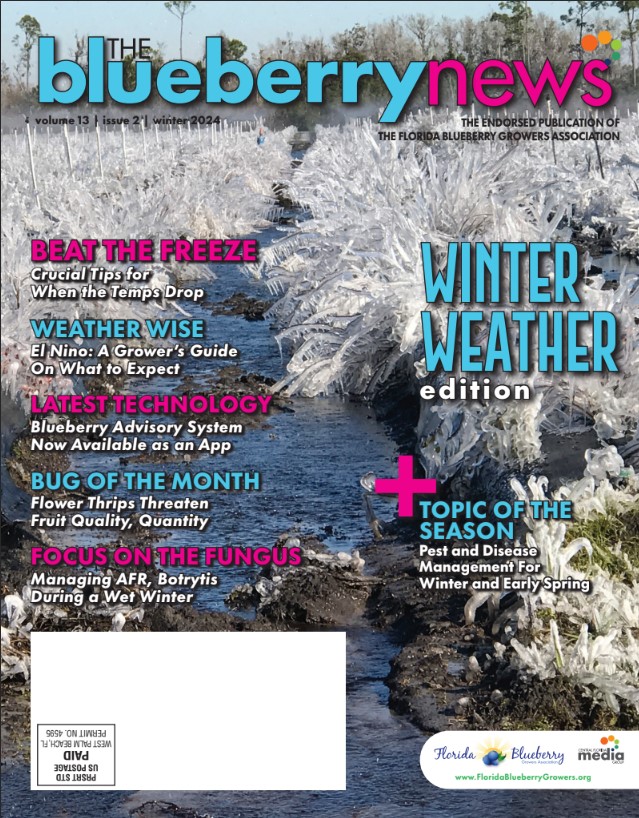What to Watch For This Season: Southern Red Mite & Blueberry Gall Midge
The two primary blueberry pests to monitor and control in fall and early winter are southern red mite and blueberry gall midge.
Southern Red Mite
The peak in southern red mite populations vary depending on the region in the state where the blueberry planting is located. If your planting is in north-central Florida (Alachua, Marion, Columbia, and Putnam counties) the peak is typically during late September and October. However, if you are in the central or south-central region (Polk, Hardee, Hillsborough, Highlands, and DeSoto counties) the peak occurs later, from late November to February when temperatures are still high and rainfall is low, as they prefer dry, dusty conditions. Drought stressed plants can be more susceptible to infestations. Their life cycle can be completed within two weeks under optimum conditions. Adults are about 0.4 mm in length and are red or brown to deep purple, with lighter colored legs. Southern red mites primarily live on the underside of leaves, feeding on plant tissues by removing leaf cell contents. This results in a bronzing of leaves (Figure 1), and a decrease in photosynthesis. The mites shed their skins, resulting in an accumulation of white skins on the underside of leaves when populations are high (Fig. 2).
Figure 1. Bronzing damage from southern red mite
Credits: D. Phillips, UF/IFAS
Figure 2. Shed skins from southern red mite
Credits: D. Phillips, UF/IFAS
Growers should scout frequently for the presence of adult mites, especially during fall/winter months. Southern red mites can be seen with a 10X hand lens. The underside of leaves should be closely examined, looking for adults and shed skins. Mites can also be monitored by looking for discolored bronze leaves. However, once symptoms have begun to appear, a moderate to severe infestation of mites is likely already present. Early identification of mite infestations and implementing management strategies before populations increase is recommended to avoid yield impacts. Water should be regularly applied to roadways or other dusty areas during hot dry periods, and sufficient irrigation is particularly important during periods of mite activity.
Three miticides, Magister® (fenazaquin), Portal® (fenpyroximate), and Kanemite® (acequinocyl) are registered for use in highbush blueberries. In field trials, Magister and Portal were the best performing miticides in terms of suppressing southern red mite populations and allowing bushes to recover from mite injury. Growers can only make one application per year using Magister and two applications per year with Portal and Kanemite. Predatory mites may also be an important management tool for southern red mite control. Additional research is needed in this area.
Blueberry Gall Midge
Gall midge larvae feed on blueberry floral bud tissues, causing brown lesions, and bud death and abortion (Figure 3). When there is heavy gall midge injury, the bloom will typically be lighter since many of these buds will abort, resulting in decreased fruit set. It should be noted that poor fruit set and excessive dropping of undeveloped green fruit can also be caused by poor pollination.
Figure 3. Blueberry gall midge larvae feeding on floral buds
Credits: O. Liburd, UF/IFAS
Gall midge larvae are difficult to kill with contact insecticides since they develop and feed inside the floral buds. Insecticide applications must be timed to control adults before they lay eggs, which requires careful monitoring. Clear sticky traps hung in blueberry bushes close to the ground can be used to monitor adults (1–3 traps per acre). Alternatively, a white bucket trap with a sticky Plexiglas top placed under bushes in direct contact with soil or pine bark can detect new adults emerging from the ground (3–5 traps per acre). Recommended chemical controls should be used when there are two or more adults present in the traps. If traps are not used for monitoring, preventive spray applications can be made. The first application should be made right before floral bud break, with a second application made ten days later. Monitoring for larvae can be done by placing young stems with buds into a ziplock type plastic bag at room temperature. Small translucent larvae that mature in 4-5 days will begin to emerge if present in the buds.
Field trials conducted by the University of Florida indicated that Exirel® (cyantraniliprole), Assail® (acetamiprid), Movento® (spirotetramat) with adjuvant, and Malathion® were effective in reducing adult populations. Larval populations were reduced with Assail®, Movento® with adjuvant and Exirel®. However, these products cannot be used when pollinators are present in the field. Delegate® (spinetoram) is typically used for gall midge management during or near bloom time. Please read the label and follow all directions for rates, frequency of application, and restrictions.
CREDITS: Dr. Oscar Liburd, Professor, UF/IFAS
& Doug Phillips, Blueberry Extension Coordinator, UF/IFAS





